There are several aspects to valuing old coins. If you have a Lincoln cent or the Lincoln wheat penny as it is commonly called, you may have a genuine rarity on your hands. But before you can determine its value, several factors are vital to know.
The Lincoln cent is a popular coin and most of them are readily accessible. This means they do not all have a high value; only coins from select years are rare and worth anything. For this penny from 1966, it is worth only a little in circulated condition.
In mint state or uncirculated conditions, the penny may be worth more, but how much is it exactly? This article explains the value, variety, errors, and other aspects of the 1966 penny.
1966 Penny Details
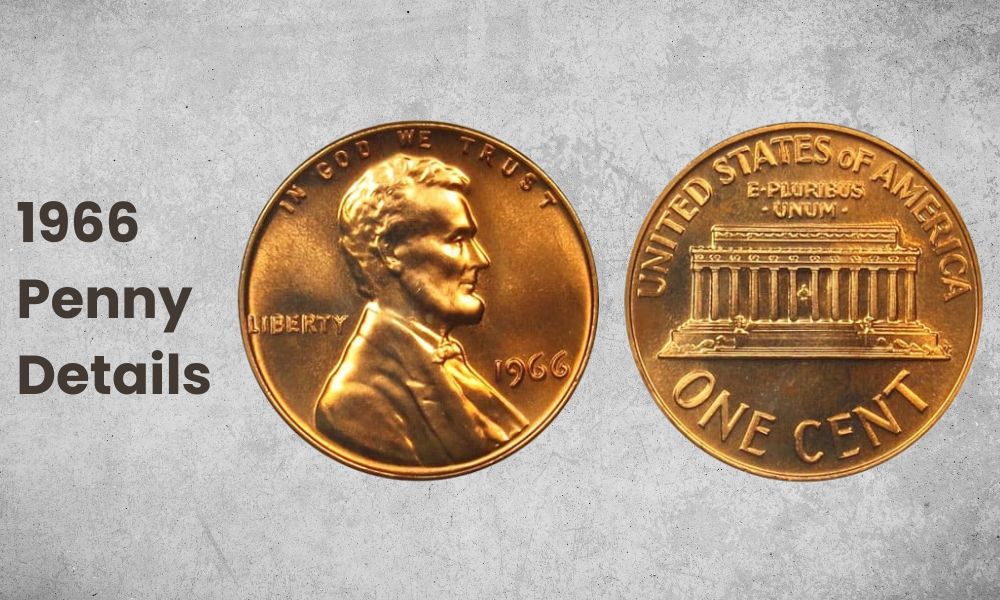
Some details of the coin add value to it. For example, the mintage in any specific year can increase or decrease a coin’s abundance on the rarity scale. This section shows general details to guide you in your valuation.
- Category: Lincoln Pennies
- Mint: Philadelphia, Denver, and San Francisco
- Mintage: 2,188,147,783
- Obverse designer: Victor D. Brenner
- Reverse designer: Frank Gasparro
- Composition: 97.5% copper, 2.5% zinc
- Edge: Plain
- Weight: 2.5 grams
- Diameter: 19.05 mm
- Thickness: 1.52 mm
While three mints struck the 1966 penny – the Philadelphia, Denver, and San Francisco mints – none of them carry a mint mark. There was a need to curtail the hoarding of coins, so the Mint Director for that year ordered that the mints strike no mint mark on the coins. Therefore, they all look the same.
However, that did not affect the mintage of the penny. There are over 2 billion one-cent coins minted that year, which is quite a high number. As a result, the penny is abundant on the rarity scale. It is readily available, and this affects its value, including on the open market.
Worthy of note is the design of this penny. Victor Brenner designed the obverse, while another artist, Frank Gasparro, designed the reverse. The reverse on this coin is not the typical stalks of wheat.
The reverse features the Lincoln Memorial in Washington D.C, a design that began in 1959 and ran until 2009 when it was changed again. The silhouette of Lincoln’s statue is obvious in the center portico of the Memorial, which is a rare design.
Also Read: Top 20 Most Valuable Old Pennies Worth Money (Penny Collection)
1966 Penny Value Chart
Since there are no mint marks on the 1966 penny, it is pretty difficult to create a value chart to differentiate the coins based on the mints. Let’s look at the values based on the coin condition.
| Mint Mark | Good | Fine | Extremely Fine | Uncirculated |
| 1966 No Mint Mark Penny Value | $0.01 | $3 | $6 | $12 |
There is not much value attached to the 1966 penny because of its abundance on the market. Collectors are usually not keen on collecting coins without special markers, and this penny falls under that category. This is especially true if the coin is too worn out, without any luster or attractive color.
The coin’s obverse bears the face of the 16th president of the United States, the same as other Lincoln cents from previous years. His bust is in profile and faces right. The words IN GOD WE TRUST appear around the top of the image, close to the rim, and LIBERTY is struck behind the image. The mint year 1966 is in front, near the rim.
On the reverse of the coin, the Lincoln Memorial is the image used for that year instead of the usual two stalks of wheat. If the coin is in excellent condition, you can see the outline of the president’s stature between the porticos.
E PLURIBUS UNUM appears on top of the image of the building, just under the words UNITED STATES OF AMERICA. The denomination ONE CENT is struck boldly at the bottom of the coin, close to the rim. You will find no mint mark on the obverse and the reverse.
Coin Grade
It is difficult to find a 1966 penny in mint state + or uncirculated condition because of the massive circulation when it was minted. However, a coin in excellent condition should have its original luster intact.
Also, all the details should be in sharp relief, including the president’s sunken cheeks, sharp jaw, the outline between the coat lapel and the shirt collar, and the tie. The same is true o the reverse; the steps, decorations, and stature must be in obvious relief.
Such coins can attract as much as thousands of dollars, especially because they are rare. In extremely fine condition, the coin still has some value but not as much as a mint state coin. Collectors value coins in this condition at a relatively lower cost, although specific markers can fetch you hundreds of dollars for it.
The lowest-valued coins are those in fine or good condition. These coins have little or no details and the luster is all gone. Under close examination, the coins should show clear marks that indicate extensive circulation.
1966 Penny Value and Varieties Guides
The penny does not have different types, so this section simply shows specific details of the coin.
1966 Penny Value
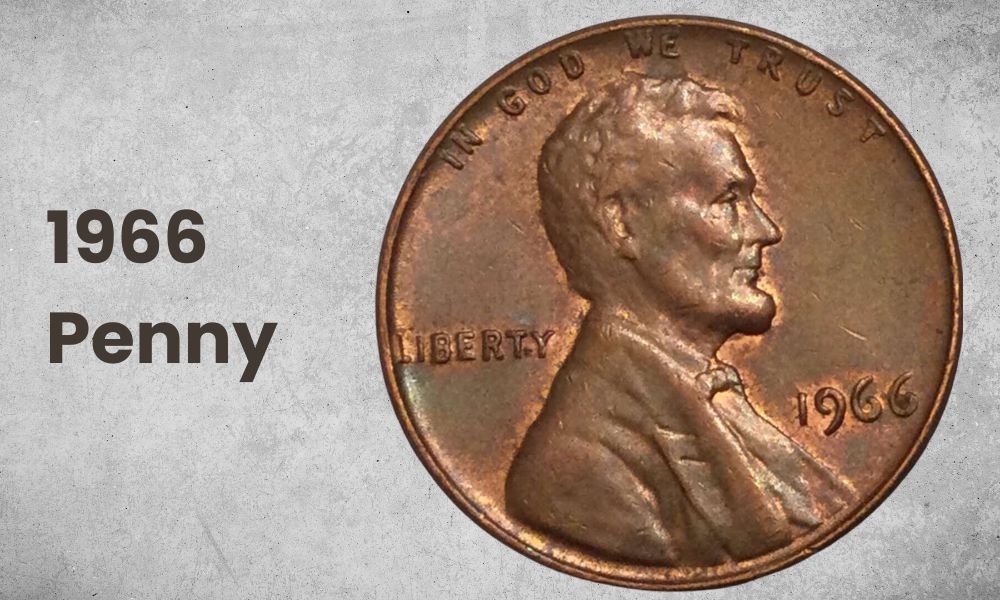
- Type: Lincoln Pennies
- Edge: Plain
- Mint mark: None
- Minting Location: Philadelphia, Denver, and San Francisco
- Year of minting: 1966
- Face value: One cent
- $ Price: $0.01 to $12
- Quantity produced: 2,188,147,783
- Designer: Victor D. Brenner and Frank gasparro
- % Composition: 97.5% copper and 2.5% zinc
- Mass: 2.5 grams
- Diameter: 19.05 mm
People typically assume the 1966 penny was struck in only one mint because of the absence of a mint mark. But that is not the case since the coin was struck in billions. Therefore, it was dispersed among three mints that year.
Denver, Philadelphia, and San Francisco mints struck the 1966 penny. But none of the have a mint mark, so there is no way to tell them apart. However, it is known that the San Francisco mint stuck over 383 million pennies and the Philly mint struck over 811 million pennies.
It is the Denver mint that struck the highest number of coins for that year, accounting for more than 991 million pennies. This was to discourage collectors from removing the coins from circulation, which had become a problem over time, necessitating the striking of more coins over the years.
Nevertheless, the San Francisco mint was designated to strike a special kind of coin for that year called the Special Mint Sets. That year saw no Proof coin production, but the special coins replaced them. More than 2 million of them were struck specially for coin collectors and have a satiny finish. These coins can fetch as much as $1,000, but their value is not very high because they are abundant and readily available to collectors.
Color
For this penny, the color and the condition are vital in determining the value since there are no mint marks. Since the penny is mostly made out of copper, collectors value red pennies more than any other color unless it is in a mint state with the original luster and color.
Copper typically changes color as air and light touch it over time to increase oxidation. The color indicates that the coin still has most, if not all, of its original color. Such a coin is graded MS 67 to 70, which is the highest on the Sheldon grading scale.
Some coins in this condition sell for about $18. One coin in an MS 67 condition once sold for about $900, and another in the same condition sold for over $6,000 at an auction over a decade ago.
A red-brown coin is not as valuable as a red coin because it shows signs of circulation and wear. The most it can fetch is about $20, but sometimes, a coin surfaces that one or more collectors scramble over. Such a coin can be valued at hundreds of dollars.
Next in line are brown coins, which are old and worn out. In the general sense, they fall under the categories of fine and good coins. Their brown color covers most of the coin’s details, making it difficult to what is left to value. Consequently, such coins may only be worth their face value or $2 at most.
History of the 1966 Penny
The penny is not much different from the rest of the pennies in the series, before and after that year. The only difference is on the reverse for some of the coins, starting from 1959 and again from 2010. The penny is still in mint today.
Its history is long and interesting because of the involvement of President Theodore Roosevelt. He felt the coins – the cent and four gold coins – were not beautiful enough with artistic value. So, he set the redesign in motion by requesting that a foreign artist is hired for the job.
The artist, Augustus Saint-Gaudens, worked on all five coins with his assistants, but it took time to get a suitable design for the cent. The same does not apply to the four gold pieces because they were easily redesigned and distributed into circulation within a few years.
At this point, the main artist was sick to death with cancer and could not continue with the work. He had to rely on his assistants to create unique designs for the cent after the other pieces went into production. The president was eager to see the results, so he turned his full attention to the work.
Shortly after this, Saint-Gaudens died and his assistants continued the work. By this time, the hundredth birthday anniversary of the assassinated president Lincoln was near and the people were already producing souvenirs and gift packs for the ceremony. So, there was some pressure to produce a coin commemorating the upcoming event.
In a bid to give in to the demands of the people and a desire to honor a fellow Republican, Roosevelt picked Victor Brenner for the design of the president on the coin’s obverse. There is no clear story about how he picked Brenner.
But the artist sculpted Roosevelt and the discussion must have happened within that period. In January 1909, Brenner was commissioned to start the design and when the president liked and approved of it, the Mint sent the design into production for the cent. The artist also designed the reverse used for the first fifty years before it was changed to an image of the Lincoln Memorial.
1966 Penny Grading
Grading a penny is usually the job of an expert, but if you are buying a 1966 penny in a package, there are small details that should tell you its value.
The Sheldon scale used to grade coins goes from 1 to 70, and while a coin can be in good, fine, extra fine, or uncirculated condition, it must be further divided into grades to get the true value.
This video explains how to grade an old coin correctly, using the Lincoln penny as part of the sample coins.
List of the 1966 Penny Errors
Some errors make the penny unique, increasing its value, whether or not they are in a mint state or worn.
1. 1966 Penny Doubled Die Obverse Error
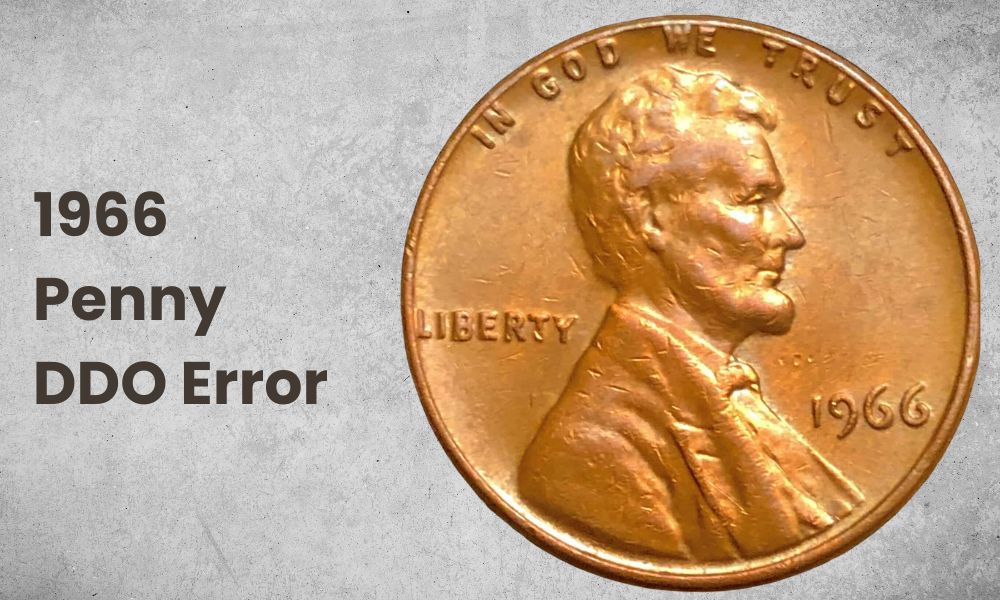
Some dies have a double image, an error that can occur during manufacturing. This error gets transferred to the planchet during striking to create a double or triple image.
The obverse of some 1966 pennies has a doubled die error on the date, especially on 1. You may also notice it in the word TRUST.
2. 1966 Penny Doubled Die Reverse
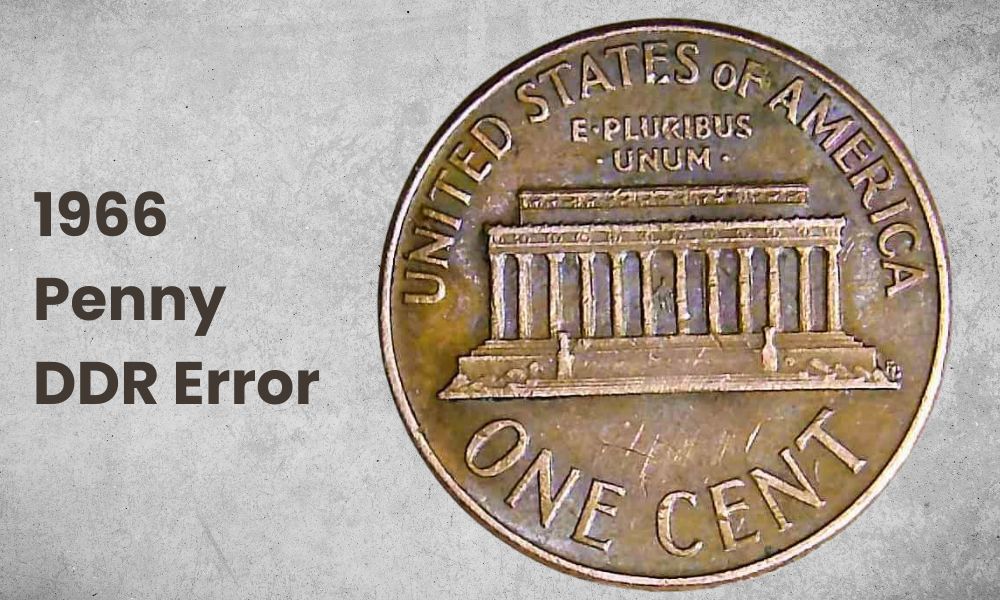
The error on the reverse appears on the denomination. The letters seem to have lines striking across them, which slightly mars their clarity and relief on the coin. Such a coin that is graded red can sell for more than $500.
3. 1966 Penny Double Strike and Die Adjustment
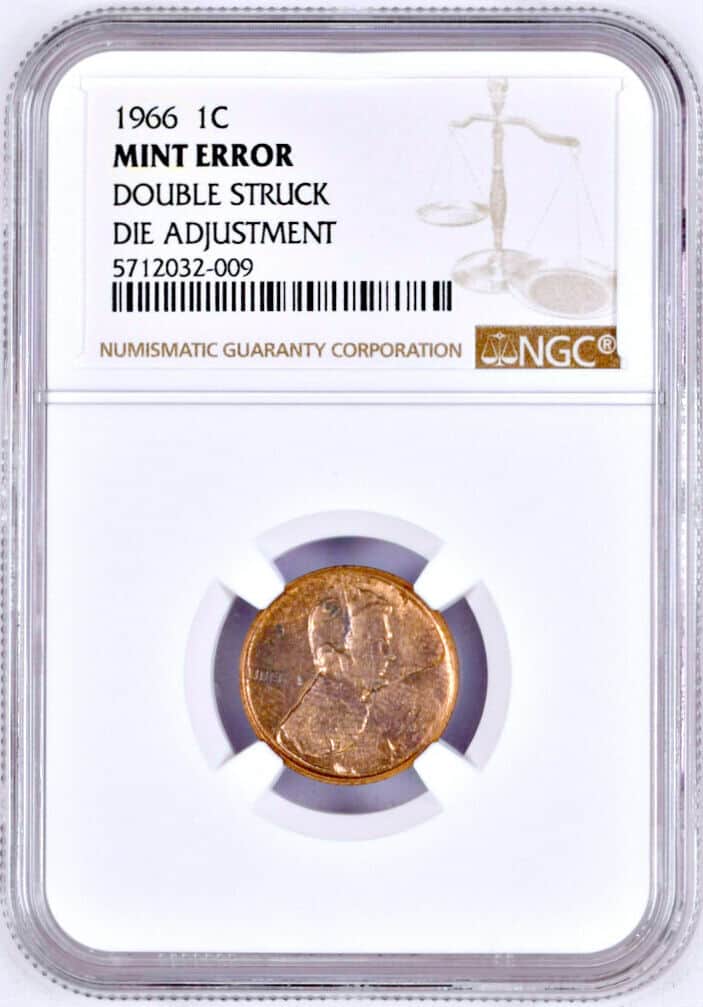
This is a rare error and combines a doubled die strike and a die adjustment error. A die adjustment error is when the officials adjust the press, causing it to strike the planchet without enough force. A coin with this error sold on eBay for about $25,000 in 2022.
The video below explains the errors and how to identify them.
1966 Penny FAQs
How do I know if my 1966 penny is worth anything?
The color, coin condition, and any errors can increase the value of a 1966 penny. So, look for errors; the more unique the error is, the more likely the coin will be to have a high value. Also, if the coin is red and in mint state, it may be worth thousands of dollars.
What penny is worth $1,000,000?
A rare 1943 Lincoln penny is one of the most valuable pennies ever struck. It sold for about one million dollars because it was accidentally struck in bronze instead of the usual zinc-coated steel. There was a rush for it when it surfaced for sale.
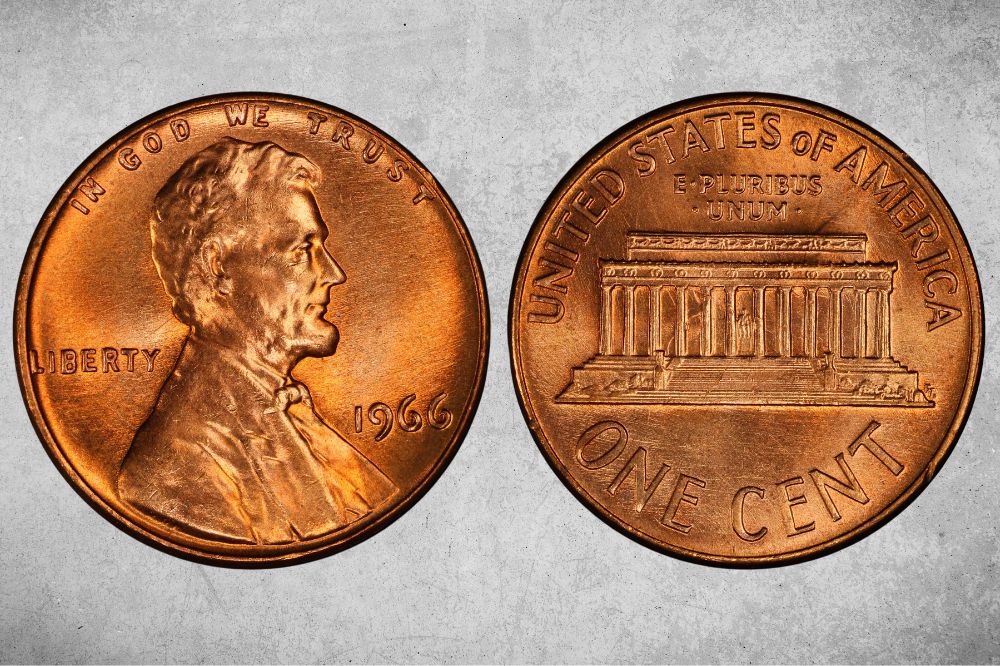
I have a large collection of what pennies from 1917 through 2009 also 1943 steel cents and foreign coins would you be interested?
I have a 1966 no mint mark used Lincoln penny it sticks to a magnet and everything is the same weight, thickness, etc and I need to figure out how much it is worth.